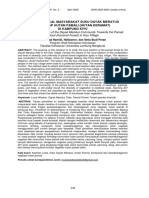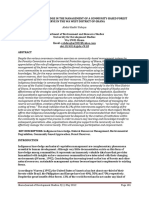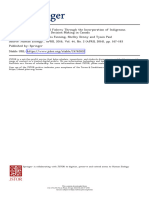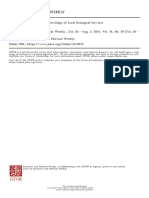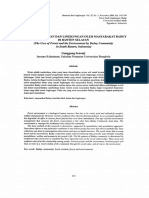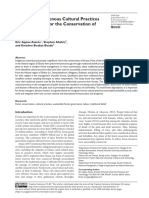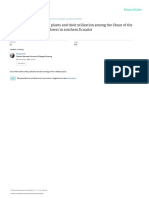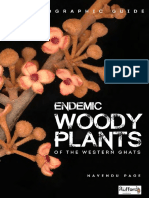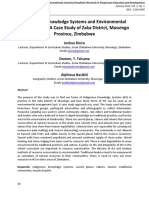Professional Documents
Culture Documents
Indigenous Peoples' Management of Forest and Wildlife Resources Case Study of Local Communities in The Southern Periphery of The Korup National Park, Southwest Region, Cameroon
Original Title
Copyright
Available Formats
Share this document
Did you find this document useful?
Is this content inappropriate?
Report this DocumentCopyright:
Available Formats
Indigenous Peoples' Management of Forest and Wildlife Resources Case Study of Local Communities in The Southern Periphery of The Korup National Park, Southwest Region, Cameroon
Copyright:
Available Formats
Volume 7, Issue 1, January – 2022 International Journal of Innovative Science and Research Technology
ISSN No:-2456-2165
Indigenous Peoples’ Management of
Forest and Wildlife Resources: Case study of Local
Communities in the Southern Periphery of the Korup
National Park, Southwest Region, Cameroon
George Agri Ambukwa, Dr. Tatah Jean-Louis Banadzem (Ph.D.)
Abstract: In Africa, most forest communities for over populations and their natural resources has made them key
centuries have developed traditional norms to ensure the actors in resource management. It has enabled them to have
sustainable management of forest and wildlife resources, knowledge systems and control mechanisms which are
in which their livelihood highly depend upon. The study related to good stewardship as, appropriate sanctionsare
was an attempt to investigate the relationship between the levied against defaulters (Saj, 2006). The management of
belief systems and taboos of the local communities in the forest/wildlife resources by local people in most African
Southern periphery of the Korup National Park (KNP), societies is often translated or manifested through belief
vis-à-vis the sustainable management of forest/wildlife system mechanisms, and taboos1. Such belief systems, myths
resources. A total of 485 out of 775 households (62.84% and taboos are local informal (quasi-statutory) institutions
effective respondents) was sampled in 13 villages in the where norms rather than laws and legislations govern natural
region. Questionnaire, interviews and field observations resource management (Ngoufo et al. 2013). Taboos are
constituted the main tools used in data collection. The considered as informal traditional institutions which are
findings revealed that some significant and endangered decentralized and self-enforced. Culture, as a tool in
wildlife species such as chimpanzees, baboons, mandrills conservation science, takes into consideration the role of
and elephants are tabooed due to the local belief of social taboos in traditional societies. Some wildlife species,
totemic kinship, which holds that some local people especially primates or large mammals are perceived by local
transform into the above animals, and killing them people as a symbol of mystical power respect; and are
implies killing the totem owners. This view was affirmed therefore considered as sacred, hence prohibited from
by 93.4% of the respondents. The chi statistic test (χ²) harvest. In a related dimension, some tabooed wildlife
value of 139.055497854, greater than the value of species are only used for sacrificial or ceremonial purposes;
significance (21.026 observed on the χ² table), as they are believed to be connected to the ancestors. Such
corroborated our findings on the view that there is an species tend to be highly protected, thus some socio-cultural
inextricable link between the belief systems and taboos of perceptions have a high propensity to sustainably manage
the local people and the sustainable management of forest/wildlife resources. Although forest communities have a
forest/wildlife resources. This implication is that these strong cultural attachment and value for some wildlife
wildlife species are fully protected for the benefit of the species, local structures to enhance or empower this
ecological system. It was found out that, the Ekpesecret appreciation are either weak or missing as a result of
society (the leopard cult) protects wildlife species in the exogenous proliferation and adulteration (Ngoufo et al.,
study area; as it regulates wildlife harvest and ensure 2013).
respect for indigenous protected areas (shrines and
sacred groves). The study recommends the integration of Our study focused on the communities living in the
indigenous belief systems and taboos linked to wildlife Southern fringes of the Korup National Park as representative
conservation into the national Forestry/wildlife law(s). area where traditional/customary norms; and belief systems
There is also need to reinforce local wildlife management still play a significant role in the sustainable management of
institutions as there are being threatened of extinction by forest/wildlife resources. In order to assess the link between
‘modernity’. This will safeguard the socio-cultural the local communities’ traditional systems, myths and taboos
wellbeing of the local communities and empower them to vis-à-vis forest/wildlife management, the following
participate in the sustainable management of hypothesis was formulated: “There is an inextricable link
forest/wildlife resources in the region. between local community belief systems/taboos and the
sustainable management of forest/wildlife resources in the
Keywords:- Indigenous people, Belief systems, Taboos, Southern periphery of the KNP”.
myths, forest/wildlife resources, conservation.
A. Study site Methods and Data Base
I. INTRODUCTION The study was carried out in the Southern periphery of
the KNP; located in the south west border of Cameroon,
Local communities inhabit most of the areas of highest
biological diversity on the planet (WWF, 2003). Local
populations and forest/wildlife resources constitute what the 1
Religious or social customs and myths prohibiting or
Declaration of Belem perceives as ‘inextricable link’ between restricting the exploitation of certain forest/wildlife resources
biological and cultural diversity’ (Etiendem, 2011). Kiss et (especially significant species)
al. (1990), argued that the close link between local (www.collinsdictionary.com,).
IJISRT22JAN082 www.ijisrt.com 728
Volume 7, Issue 1, January – 2022 International Journal of Innovative Science and Research Technology
ISSN No:-2456-2165
within the Universal Transverse Mercator (UTM) grid zone 442, 750-442, 550-170m North and 495,090-536,950m East
32. Specifically, it is located between the UTM coordinates (WWF et al., 2003).
Fig 1: Location of the Korup region in the Western Border of Cameroon
Source: Atlas forestier interactif du Cameroun, 2021
The KNP and its support zones cover a surface area of between September and November to cover the wet and dry
1 260km² (KNPMP, 2017). Thirteen villages; Akpasang, seasons. Some household heads were either not available or
Erat, Ekon 1, Ekondokondo, Fabe, Mokange, Monsegiselie, were unwilling to collaborate with the survey team, as they
Esoki, Massaka, Mofako, Mokange, Ngenye and Mokango were reluctant to provide responses to the questions posed.
were sampled for the investigation. Due to the small number Our survey covered a wide range of issues including
of households observed in the sampled villages, the research knowledge on the availability of forest/wildlife resources,
team opted to interview all the household heads in the area. socio-cultural values and use of the resources, belief
In this vein, a total of 485 out of 775 respondents effectively systems, myths and taboos relevant to their management. In
responded to the questionnaire, giving an effective order to obtain in-depth information on our study theme, the
respondents’ success rate of 62.58%. Data were collected questionnaire were complemented with interviews.
IJISRT22JAN082 www.ijisrt.com 729
Volume 7, Issue 1, January – 2022 International Journal of Innovative Science and Research Technology
ISSN No:-2456-2165
Fig 2: Location of sampled communities for the study area
Source: Atlas forestier interactif du Cameroun, 2021
In this vein, local resource persons such asvillage hypothesis.The Pearson’s Chi Square Test formula is stated
heads, elders and members of the Ekpe society (Leopard thus:
cult) were interviewed. They were posed both opened and (𝑂−𝐸)2
𝑥2 = ∑ 𝐸 Or 𝑥 2 = 𝑆𝑢𝑚 𝑜𝑓 (𝑂𝑏𝑠𝑒𝑟𝑣𝑒𝑑 −
closed questions in order to get a grasp of some pertinent
local perceptions related to forest/wildlife management in 𝐸𝑥𝑝𝑒𝑐𝑡𝑒𝑑)2 ̸𝐸𝑥𝑝𝑒𝑐𝑡𝑒𝑑
Southern Korup; in order to reinforce the standardized
Where 𝑥 2 = 𝐶ℎ𝑖 𝑆𝑞𝑢𝑎𝑟𝑒
surveys. Data was built-up using qualitative and quantitative
∑ = Summation
techniques. In this vein, tables, percentages and photographs
O = Observed Frequencies
were used to present data. Thechi square statistic test (χ²)
E = Expected Frequencies
was employed as an inferential technique to test our
df = n-1
Alpha level = 0.05
IJISRT22JAN082 www.ijisrt.com 730
Volume 7, Issue 1, January – 2022 International Journal of Innovative Science and Research Technology
ISSN No:-2456-2165
N° Village Estimated Total N° of Number effectively % of effective
population Households interviewed respondents
01 Fabe 532 67 41 61.1
02 IkondoKondo 416 74 53 71.6
03 Akpasang 669 84 37 44.0
04 Erat 856 119 83 69.7
05 Ekon 1 763 103 48 46.6
06 Mosongisele 438 71 62 83.7
07 Esoki 379 54 35 64.8
08 Massaka 286 69 41 59.4
09 Mofako 208 27 16 59.2
10 Mokange 273 26 15 57.6
11 Ngenye 176 21 14 66.6
12 Ikassa 196 28 19 67.8
13 Mokango 191 32 21 65.6
Total 13 3 383 775 485 62.58%
Table 1: Communities in the southern Periphery of the KNP Sampled for the Survey
Source: BUCREP (2005); village chiefs (2021); II. RESULTS AND DISCUSSION
fieldwork (2021)
A. Indigenous Management of wildlife resources using
The selection of the communities was based mainly on taboos
the following criterion: villages with a rich cultural Field investigation reveals that local norms to regulate
background, with existing traditional institutions the exploitation of wildlife resources are vested in taboos.
The harvest of some endemic/endangered wildlife species
such as chimpanzees, mandrills, elephants and baboons have
been strictly prohibited by local norms coordinated by the
village heads and local institutions such as the Ekpe society.
Injunctions a placed on local norms to reinforce their
application by the local populations. Table 2 below presents
the views of respondents as regards some wildlife species
classified by local norms as tabooed species.
Questionnaire item Sampled village Nº of Agreed Disagreed Neutral % Agreed
respondents
Akpasang 37 36 00 01 97.3
Erat 83 81 00 02 97.6
Ekondokondo 53 53 00 00 100
Ekon 1 48 43 00 05 89.5
Fabe 41 38 00 03 92.6
Chimpanzees, gorillas and Mosongisele 62 62 00 00 100
baboons are tabooed wildlife Esoki 35 31 00 04 88.5
species in your community Massaka 41 37 00 04 90.2
(i.e. must not be hunted)? Mofako 16 15 00 01 93.7
Mokange 15 12 00 03 80
Ngenye 14 12 00 02 85.7
Ikassa 19 17 00 02 89.4
Mokango 21 16 00 05 76.1
Total 485 453 00 32 93.4
Table 2: Respondents’ perceptions on whether or not wildlife species in the Korup region
Source : fieldwork, 2021
93.4% (n=453) of the respondents affirmed the view tabooed wildlife species. This believe have existed since the
that some endangered wildlife species such as the inception of the local communities in the Korup forest since
chimpanzees, baboons and elephants are tabooed species. It the 14th century (source).The charismatic morphology and
was also noticed that the taboo concept is being gradually the human-like nature of these animals were advanced as the
eroded (especially) amongst the youths as 6.6% (n=32) of main reasons that have caused local people to generate
the respondents were innocent (neutral) on this passion and sympathy for these Great Apes. In this
questionnaire item. It is claimed by the local populations dimension, local institutions such as the ‘Ekpe’ society (the
that no member in the community is allowed to hunt or kill Leopard cult), are charged with the responsibility to
IJISRT22JAN082 www.ijisrt.com 731
Volume 7, Issue 1, January – 2022 International Journal of Innovative Science and Research Technology
ISSN No:-2456-2165
safeguard the sustainability of such wildlife species. Local such as epilepsy and body rashes to excommunication from
sensitisation and check mechanisms have also been put in the village.
place to monitor and refrain anyone from harvesting these
tabooed species.In order to reinforce the sustainable Plate 1 below presents pictures of some tabooed
wellbeing of these animal species, traditional sanctions are wildlife species in our study site.
being meted on culprits; ranging from dreaded deceases
2 3
1
Plate 1: Some charismatic tabooed wildlife species (mammals) in the Korup region
1= Preuss’s red colobus monkey (piliocolobus badius), with juvenile in the wild
2= Mandrill (mandrill’s sphinx)
3= Chimpanzee (pan troglodytes), with juvenile
4= Baboon (genus papio)
Source: retrieved from www.wildlife.org/www.britannica.com.primates. (05/04/2021)
From plate 1 above, the mammals exhibit human-like attitudes of petting and protecting their kids in order to ensure the
sustainability of their lineage. Community perceptions towards large mammals can be termed communal, and constitutes a salient
example of man and nature in harmony. This local protection mechanism justifies why the Korup forest hosts about one quarter of
the world’s endangered wildlife species (WWF, 2002).The local conservation of the above wildlife species through taboos has
also been strengthened by the local perception of totemic kinship2. Consequently, people are scared of killing totem owners. Other
totemic wildlife species identified during our survey were gorillas, pythons and the bush baby (nagapies).Whether or not the myth
about wildlife-totem relationship is real, the beneficial effect of it on the protection of wildlife is unquestionable.
B. Local Populations Perceptions on the availability of some animal species in the wild
Our findings also revealed that local people have a mastery of most wildlife species and their availability status in the forest, as
depicted on table 3 below.
English Name Scientific Name Local Name (in Traditional Perceptions
Orock dialect) on availability
Elephant Loxodonta Njoku animal-totem
Buffalo Nyate Scarce
2
Totemic kinship is a local belief held by the Korup inhabitants thatlocal community members transform into these Great Apes in
the forest. The killing of such wildlife species is susceptible to killing their relatives who are totem owners.
IJISRT22JAN082 www.ijisrt.com 732
Volume 7, Issue 1, January – 2022 International Journal of Innovative Science and Research Technology
ISSN No:-2456-2165
Chimpanzee Pan Troglodytes v. nchewu animal-totem
Leopard Panthera pardus murchu fairly available
Bush Pig Ptomochoerus porcus ngowa Abundant
Mandrill Mandrillus sphinx sombo often seen
Fox (bush dog) ? Esawbor often seen
CR. Gorilla Gorilla g. dielhi ewake animal totem
Python Python sebac kuma scarcely observed
Giant Pangoline Manis gigantean ichayaphea fairly available
Tiger Panthera tigris tigris Ngoh Scarce
Lion Panthera leo ngiyer Scarce
Hippopotamus Hippopotamus amphibius njocku cha mariba Available
Red Capped Mangabey Cercocebus torquatus Mbi Not frequently seen
White Nose Guenon Cercopithecus nictitans Koi Scarce
Pangolin Manidae Icha Abundant
Preuss’s Red Colobus Piliocolobus Preussi mberri Scarce
Crocodile Osteolaemus t. mokombe available
Alligator Alligator mississippiensis ngando avalailable
Yellow backed Duiker C. silvicultor nchibo often seen
Red deer Cervus elaphus mbindi not often seen
Blue backed duiker C. monticola issery Scarce
Pocupine Hystrix cristata ngomba abundant
Giant Lizard Kaupifalco monogrammicus ngombe Scarce
Putty nosed Monkey C.nictitans nictitans Koi not often seen
Water Chevrotain Hyemoschus aquaticus Jeeh Scarce
Baboons Papio baboons Animal totem
Table 3: Respondents’ Local Knowledge and Perceptions on the Availability of Some Wildlife Species in Southern Korup.
Source: Fieldwork, 2021
It was observed from the responses and views of the win-win man-animal relationship. For another reason, the
local people on the types and availability of wildlife, that consumption of bush baby (sc. name), is proscribed to
they have a good mastery of the appellations and the current pregnant women, because it is believed that they may give
status of animal population in the wild. Through long birth to off springs that take the out-look of the animal.
experience, observation and experimentation, local people
cumulated adequate knowledge on wildlife in the Korup Some wildlife species forbidden from pregnant women
ecology. It was diagnosed that the tabooed wildlife species Although the female folk constitutes the majority of the
including Chimpanzees, Mandrills, baboons and elephants, sex structure in the region, they are being regulated from
represent human totems in the area, thus benefiting from the eating some wildlife species as observed on table 4 below
English Name Pidgin Name Scientific Name Restriction motive
(belief)
Red-eared monkey mbick mbock Cercophithecus erythrotis The animal coughs, if consumed by the
pregnant woman, the expected baby will be
infected with chronic cough
Red River hog ngume Potamochoerus Porcus The animal’s activities are associated with
witch-craft. It leads to miscarriages if eaten by
a pregnant woman
Terrestrial tortoise nguit Chelonoidis denticulate The child will walk sluggishly as the tortoise
if eaten by the pregnant woman
Brush-tailed porcupine nyup Atherurus africana The animal is believed to be recalcitrant. The
child will be stubborn if eaten by the mother
during pregnancy. The child’s intellectual
capacity is also negatively affected.
Table 4: Some wildlife species banned from consumption by women
Source: Fieldwork, 202
The restriction of pregnant women from consuming women are those to determine the meals to be prepared for
some wildlife species has undoubtedly reduced the hunting the household. It was observed during field work that this
of these species. This belief is a significant local tool used in believe has been extended to children who imitate their
protecting wildlife in southern Korup based on the fact that
IJISRT22JAN082 www.ijisrt.com 733
Volume 7, Issue 1, January – 2022 International Journal of Innovative Science and Research Technology
ISSN No:-2456-2165
mothers by refraining from the consumption of these from nearby resources and value nature for the ecological
wildlife species. services it provides. Hunting and logging are usually
prohibited in Sacred Groves. Developmental projects are
C. Shrines and Sacred Forests as Indigenous Protected also not being allowed in these abodes. They represent
Areas for wildlife conservation indigenous in-situ biodiversity conservation hotspots. It was
Indigenous Protected Areas (IPAs) are traditionally observed that the size of shrines and sacred forest range on
demarcated portions of the forest that are believed to host the average from about 20 m² to several hectares
the gods or ancestral spirits of the village. They are patches respectively. Such indigenous protected areas were observed
of primeval forest that the local people protect as abodes of spotted in most village peripheries in our study area.
deities. Such ‘ecosystem-people’ draw their livelihoods
Questionnaire item Sampled village Nº of respondents Agreed Disagreed Neutral % Agreed
Akpasang 37 36 00 01 97.3
Erat 83 83 00 00 100
Ekondokondo 53 53 00 00 100
Ekon 1 48 48 00 00 100
Fabe 41 41 00 00 100
Shrines and Sacred Forests Mosongisele 62 62 00 00 100
have been carved out in your Esoki 35 35 00 00 100
community? Massaka 41 41 00 00 100
Mofako 16 16 00 00 100
Mokange 15 15 00 00 100
Ngenye 14 11 00 03 78.5
Ikassa 19 15 00 04 71.4
Mokango 21 20 00 01 95.2
Total 485 476 00 09 93.4
Table 5: Respondents perceptions on the existence and role of Indigenous Protected Areas (IPAs) in their community.
Source: Field work, 2021
A majority of the respondents affirmed the view that respected by the local people over the past decades. These
indigenous protected areas have been carved out in their shrines and sacred groves have protected the wild from time
community; which have existed and are highly being immemorial till present.
Fig. 3: Spatial distribution of Indigenous Protected Areas (Shrines/Sacred) in the Korup region
Source: Atlas forestier interactif du Cameroun, 2021
IJISRT22JAN082 www.ijisrt.com 734
Volume 7, Issue 1, January – 2022 International Journal of Innovative Science and Research Technology
ISSN No:-2456-2165
According to the respondents, shrines and sacred sustainability of the village (i.e. good crop harvests, health,
groves are visited occasionally by influential members of the marriages, births) are directly to the sacrifices performed in
village such as the chief, landlords, and the members of the these IPAs. As a matter of fact, each village is possessed of
Ekpe society. During such visits, traditional rites are a shrine and/or sacred grove for socio-economic and cultural
performed for the cleansing and over-all wellbeing of village wellbeing and security of village members.
members. It is believed that the socio-economic
a 3
Plate 2: Some indigenous shrines and sacred groves (snapped by g. Agri, 2021)
1: Ikondokondo shrine ‘moboko’; 2: Ekon 1 sacred grove; 3: Mosengesilie sacred grove (note (a) the peace plant symbolizing
community solidarity)
Indigenous Institutions involved in Wildlife Conservation in the study area
Based on our field findings, the Ekpe society is the main traditional institution that caters for the sustainability of forest/wildlife
resources in the area. Fines are levied by this institution by community members that kill tabooed or restricted wildlife species.
Membership into this cult is patrimonial. This implies that only the male is admitted into the cult upon the dead of his father
(deceased member of the cult). The Ekpe society has ensured the conservation of most forest segments in the region as its
members have a vigilant committee to check any illegal practice in the Ekpe forest.
IJISRT22JAN082 www.ijisrt.com 735
Volume 7, Issue 1, January – 2022 International Journal of Innovative Science and Research Technology
ISSN No:-2456-2165
Name of Scope Estimated average Function Associated Sanctions Community
Institution surface area (in KM) Attitude
The Ekpe Found in all Safeguards the Fines, mystical deadly
Society the sampled ≥ 10 wellbeing of diseases meted on defaulters, Highly
villages wildlife resources possible exile respected
Table 6: some components of the traditional forest/wildlife conservation institution in the study area
Source: Field work (interview with village heads/elders, 2021)
Verification of hypothesis using the Chi Square (χ²) management of forest/wildlife resources in the Southern
statistic test periphery of the KNP”.
The chi square (χ²) statistic test is being used to test our
specific hypotheses to verify that the findings do not occur H1: There is an inextricable link between local
by chance. community belief systems/taboos and the sustainable
management of forest/wildlife resources in the Southern
Ho: There is no inextricable link between local periphery of the KNP”.
community belief systems/taboos and the sustainable
Questionnaire item Sampled village Nº of Agreed Disagreed % Agreed
respondents
Akpasang 37 37 00 100
Erat 83 83 00 100
Ekondokondo 53 53 00 100
Ekon 1 48 48 00 100
Your belief systems, myths Fabe 41 41 00 100
and taboos have conserved Mosongisele 62 62 00 100
forest/wildlife resources in Esoki 35 35 00 100
your community? Massaka 41 41 00 100
Mofako 16 16 00 100
Mokange 15 15 00 100
Ngenye 14 11 00 100
Ikassa 19 19 00 100
Mokango 21 21 00 100
Total 485 485 00 100
Table 7: respondents views on the link between their belief systems, myths and taboos; and forest/wildlife management
Source: Fieldwork, 2021
It can be observed from 7 above that all the respondents affirmed the view that their belief systems and taboos have
safeguarded forest/wildlife resources in the Korup.
Category Observed Expected Obs.-Exp. (Obs.-Exp.)² (Obs.-Exp.)²/Exp.
Akpasang 37 37.3 -0.3 0.09 0.0024128686327
Erat 83 37.3 45.7 2 088.49 55.991689008042
Ekondokondo 53 37.3 15.7 246.49 6.6083109919571
Ekon 1 48 37.3 10.7 114.49 3.0694369973190
Fabe 41 37.3 3.7 13.69 0.3670241286863
Mosongisele 62 37.3 24.7 610.09 16.356300268096
Esoki 35 37.3 -2.3 5.29 0.1418230563002
Massaka 41 37.3 3.7 13.69 0.36702412868096
Mofako 16 37.3 -21.3 453.69 12.163270777479
Mokange 15 37.3 -22.3 497.29 13.332171581769
Ngenye 14 37.3 -23.3 542.89 14.554691689008
Ikassa 19 37.3 -18.3 334.89 8.9782841823056
Mokango 21 37.3 -16.3 265.69 7.1230563002680
∑n 485 37.3 139.05549597854
Table 8: Chi square (χ²) analysis on the relationship between indigenous belief systems/ taboos and the sustainable management of
forest/wildlife resources in the study area
Source: Computed from table X above
IJISRT22JAN082 www.ijisrt.com 736
Volume 7, Issue 1, January – 2022 International Journal of Innovative Science and Research Technology
ISSN No:-2456-2165
(𝑂−𝐸)2 pro-wildlife management belief systems and taboos that can
𝑥2 = ∑ 𝐸 Or 𝑥 2 = 𝑆𝑢𝑚 𝑜𝑓 (𝑂𝑏𝑠𝑒𝑟𝑣𝑒𝑑 −
2
be exploited, by ensuring their full and effective
𝐸𝑥𝑝𝑒𝑐𝑡𝑒𝑑) ̸𝐸𝑥𝑝𝑒𝑐𝑡𝑒𝑑 participation. The Korup region hosts about a quarter of the
world’s endemic biodiversity due to the sustainable
Where 𝑥 2 = 𝐶ℎ𝑖 𝑆𝑞𝑢𝑎𝑟𝑒
forest/wildlife conservation models and notions embedded
∑ = Summation in the culture/tradition of the local people. Modern
O = Observed Frequencies conservation efforts may be thwarted, especially in a long
E = Expected Frequencies term if the wildlife management perceptions of the local
Degree of freedom (df) = n-1 (13-1) =12 people are not incorporated in management practices,
Alpha level = 0.05 through their maximum and effective participation in the
affairs of the wildlife management in Southern Korup.
Thus, 𝑜𝑢𝑟 𝑐𝑎𝑙𝑐𝑢𝑙𝑎𝑡𝑒𝑑 𝑥 2 of 139.05549597854 far
exceeds the value on the chi square level of significance REFERENCES
indicated on the statistic table (21.026). In this regard the
[1.] Etiendem D.N., Hens L., Pereboom Z., (2011).
alternative hypothesis is retained while the null hypothesis is
Traditional knowledge systems and the conservation of
discarded. In other words, our results reveal that there is an
Gross River Gorillas: A case study of Bechati,
inextricable relationship between the belief systems, myths
Fossimondi, Besali; Cameroon.
and taboos of the local communities in the Southern
[2.] Jimoh S. O., Ikyaaba E.T., (2012). The role of
periphery of the Korup National Park and the conservation
traditional laws and taboos in wildlife conservation in
of forest/wildlife resources. The computed results tie with
the Oban Hill Sector of Cross River National Park
respondents’ views as 100% affirmed the fact that there is a
(CRNP), Nigeria. 213-39; 207-223.
link between their local perceptions and the sustainable
[3.] Ntiamoa-Baidu Y. (1995). Indigenous versus
management of forest/wildlife resources. The existence of
introduced biodiversity conservation strategy: The case
some tabooed wildlife species, the restriction of pregnant
the case of protected area systems in Ghana, African
women from consuming some animals, and the creation of
Biodiversity. F.,
creation of indigenous protected areas are sufficient
[4.] Berkes F., (2005). Social systems, ecological systems,
indicators to corroborate the computed results.
and property rights. In: rights to nature: ecological,
III. RECOMMENDATIONS economic, cultural and political principles of
institutions for the environment, Island press,
The study recommends the reinforcement of local Washington D.C. USA.
forest and wildlife management institutions such as the [5.] Saj T. L.; Mather C.; Sicotte P. (2006).Traditional
‘Ekpe’ society and its forest. This is justified by the fact that taboos in biological conservation: The case of Colobus
sacred groves and shrines are tabooed areas wherein vallerosus in the Boabeng-Fiema Monkey Sanctuary,
wildlife, especially significant endangered species are being Central Ghana. Social Science Information.
protected for the socio-cultural wellbeing of the present and [6.] R. Ngoufo, NK Yongyeh, EE Obioha, KS Bobo, SO
future generations.There is also the need to mainstream the Jimoh, M Waltert (2013). Social norms and cultural
indigenous belief systems and taboos link to natural resource services-community belief system and use of wildlife
management into the Cameroon Forestry/Wildlife products in the Northern periphery of the Korup
law.Village chiefs and elders can be given the chance to National Park, South-West Cameroon.
sensitize the youths on the significance of indigenous belief [7.] World Wide Fund for Nature (2003): Community
systems and taboos in enhancing the wellbeing of wildlife Involvement in Management of the Arfak Mountains
and its habitat. Such an approach has proven successful in Nature Reserve (Indonesia), Jakarta.
India and most parts of East Africa where local people are [8.] Whyte, A.V.T. (1977). Guidelines for Field Studies in
encouraged to effectively manifest their cultural values in Environmental Perception. United Nations
sustaining the wild. Educational, Scientific and Cultural Organization,
UNISCO Paris, France.
IV. CONCLUSION [9.] White, L. and A, Edwards (2000). Conservation
Research in the African Rainforest: a technical
The cultural values of the local people largely work in Handbook. The Wildlife Conservation Society, New
favor of sustainable wildlife conservation. York. Pp. 444.
[10.] Westoby, J. (1987). Introduction to World Forestry:
As earlier mentioned, significant wildlife species such
People and their trees. Basil Blackwell Ltd, Oxford,
as chimpanzees, mandrills and baboons have been tabooed
UK, pp. 228.
since they are locally perceived as animal-totems.
[11.] Agri, A. (2015). Challenges in the Sustainable
Unfortunately, no efforts have been made by wildlife
Management of Wildlife Reserves: Case of the
management officials to reinforce this perception through
Kagwene Gorilla Sanctuary in the Western Boarder of
the enhancement of local community participation. More so,
Cameroon. Master’s thesis.
vital local pro-wildlife conservation institutions such as the
[12.] Agnes Kiss(1990), Living with Wildlife: Wildlife
Ekpe society (the Leopard’s cult) have played a significant
Resource Management with Local Participation in
role in the management of wildlife resources in the Southern
Africa. World Bank Technical Paper No 130.The
section of Korup. The local population is embedded with
World Bank, Washington, DC.
IJISRT22JAN082 www.ijisrt.com 737
You might also like
- Local Livelihoods and Protected Area Management: Biodiversity Conservation Problems in CameroonFrom EverandLocal Livelihoods and Protected Area Management: Biodiversity Conservation Problems in CameroonNo ratings yet
- Socio-Economic and Environmental Factors Influencing Human-Wildlife Conflict in Nimule National Park - South SudanDocument18 pagesSocio-Economic and Environmental Factors Influencing Human-Wildlife Conflict in Nimule National Park - South SudanInternational Journal of Innovative Science and Research TechnologyNo ratings yet
- Ajol File Journals - 340 - Articles - 237126 - Submission - Proof - 237126 4057 572693 1 10 20221125Document9 pagesAjol File Journals - 340 - Articles - 237126 - Submission - Proof - 237126 4057 572693 1 10 20221125Ebinabo EriakumaNo ratings yet
- 5370 14243 2 PBDocument9 pages5370 14243 2 PBMonalisa YayaNo ratings yet
- Cultural Diversity and Biodiversity Conservation in Remote Himalayan RegionsDocument8 pagesCultural Diversity and Biodiversity Conservation in Remote Himalayan RegionsBen WilliamsNo ratings yet
- Indigenous Knowledge in The Management of A Community-Based Forest Reserve in The Wa West District of GhanaDocument14 pagesIndigenous Knowledge in The Management of A Community-Based Forest Reserve in The Wa West District of GhanaKedir HussenNo ratings yet
- Reinventarization of Living Procedures, Local Knowledge, and Wisdom To Environment Halmahera, 2021Document8 pagesReinventarization of Living Procedures, Local Knowledge, and Wisdom To Environment Halmahera, 2021Arifin Muhammad AdeNo ratings yet
- protected areas in northern TanzaniaDocument184 pagesprotected areas in northern Tanzaniajerzyk.w.locieNo ratings yet
- 13 Dil Kuma Limbu - 1336385427cmlbDocument93 pages13 Dil Kuma Limbu - 1336385427cmlbMishal LimbuNo ratings yet
- Improving The American Eel Fishery Through The Incorporation of IndigenousDocument18 pagesImproving The American Eel Fishery Through The Incorporation of IndigenoussergiolefNo ratings yet
- 161-Article Text-699-3-10-20220603Document12 pages161-Article Text-699-3-10-20220603Fuad FirmansyahNo ratings yet
- Indigenous Communities' Knowledge of Local Ecological ServicesDocument12 pagesIndigenous Communities' Knowledge of Local Ecological ServicessouryadasNo ratings yet
- Pemanfaatan Hutan Dan Lingkungan Oleh Masyarakat Baduy Di BantenDocument7 pagesPemanfaatan Hutan Dan Lingkungan Oleh Masyarakat Baduy Di BantenDella AndriyaniNo ratings yet
- Pemanfaatan Hutan Dan Lingkungan Oleh Masyarakat Baduy Di BantenDocument7 pagesPemanfaatan Hutan Dan Lingkungan Oleh Masyarakat Baduy Di BantenAzi Gunawan Arafiana PutraNo ratings yet
- The Plant Wisdom of Dayak Ot Danum People in Central KalimantanDocument14 pagesThe Plant Wisdom of Dayak Ot Danum People in Central KalimantanMuhammad Faiq FadhllurohmanNo ratings yet
- 2018 BortoDocument26 pages2018 BortoBortoNo ratings yet
- The Use of Indigenous Cultural Practices by The Ashantis For The Conservation of Forests in GhanaDocument7 pagesThe Use of Indigenous Cultural Practices by The Ashantis For The Conservation of Forests in GhanaMega OktavianyNo ratings yet
- 150-Article Text-466-1-10-20221224 - 2Document13 pages150-Article Text-466-1-10-20221224 - 2Rio ZulkarnainNo ratings yet
- Species Richness and Distribution of Primates in Disturbed and Converted Forest Landscapes in Northern BorneoDocument11 pagesSpecies Richness and Distribution of Primates in Disturbed and Converted Forest Landscapes in Northern Borneonadaraja1706No ratings yet
- Deforestation Forest Scarcity and Adaptation Stategy in Sapele Delta State NigeriaDocument9 pagesDeforestation Forest Scarcity and Adaptation Stategy in Sapele Delta State NigeriaIJARP PublicationsNo ratings yet
- Neyra-Cabatac Et Al. - Indigenous Agroforestry in A Changing Context The Case of The Erumanen Ne MenuvuDocument10 pagesNeyra-Cabatac Et Al. - Indigenous Agroforestry in A Changing Context The Case of The Erumanen Ne MenuvuIrjay RollodaNo ratings yet
- Conservat Sci and Prac - 2023 - Shahi - What Drives Local Communities Attitudes Toward The Protected Area Insights FromDocument11 pagesConservat Sci and Prac - 2023 - Shahi - What Drives Local Communities Attitudes Toward The Protected Area Insights FromThazin HtayNo ratings yet
- Socio-Economic Impacts of The Protection of Natural Resources On The Population, Case of Marojejy National ParkDocument10 pagesSocio-Economic Impacts of The Protection of Natural Resources On The Population, Case of Marojejy National ParkInternational Journal of Innovative Science and Research TechnologyNo ratings yet
- Ramechhap Project Agroforestry NabinDocument21 pagesRamechhap Project Agroforestry NabinJeetendra GautamNo ratings yet
- Community-Based Conservation Damar (Shorea Javanica) Intraditional Zone Bukit Barisan National ParkDocument8 pagesCommunity-Based Conservation Damar (Shorea Javanica) Intraditional Zone Bukit Barisan National ParkNur KhadijahNo ratings yet
- WP Policy Terrain in PA LandscapesDocument41 pagesWP Policy Terrain in PA Landscapeskenfack sergeNo ratings yet
- Sustainable Forest Management As A Form of Community Resistance in BaliDocument14 pagesSustainable Forest Management As A Form of Community Resistance in BaliYoga KarismaNo ratings yet
- Populations and Sustainability Case StudiesDocument16 pagesPopulations and Sustainability Case StudiesRipRasherNo ratings yet
- Traditional Religion and Natural Resources' - A Reflection On The Significance of Indigenous Knowledge Systems On The Utilisation of Natural Resources Among The Ndau People in South-Eastern ZimbabweDocument6 pagesTraditional Religion and Natural Resources' - A Reflection On The Significance of Indigenous Knowledge Systems On The Utilisation of Natural Resources Among The Ndau People in South-Eastern ZimbabwechazunguzaNo ratings yet
- Forest-Culture Relationship in NSO and Mbiame Fondoms Case of The Montane Forests of Ngongbaa, Kovifem and Kovkinkar, North West CameroonDocument17 pagesForest-Culture Relationship in NSO and Mbiame Fondoms Case of The Montane Forests of Ngongbaa, Kovifem and Kovkinkar, North West CameroonInternational Journal of Innovative Science and Research Technology100% (1)
- Sexual, Allometric and Forest Cover Effects On Giant Anteaters' Movement EcologyDocument15 pagesSexual, Allometric and Forest Cover Effects On Giant Anteaters' Movement EcologyKatia FacureNo ratings yet
- Scientific Knowledge Based Culture and Local Wisdom in Karimunjawa For Growing Soft Skills ConservationDocument7 pagesScientific Knowledge Based Culture and Local Wisdom in Karimunjawa For Growing Soft Skills ConservationLopo Milenial ChanelNo ratings yet
- REPORT:Endangered Elephants in Megatha Forest Karen State Burma-Engl.Document78 pagesREPORT:Endangered Elephants in Megatha Forest Karen State Burma-Engl.Pugh JuttaNo ratings yet
- Indigenous Knowledge of Rural Communities in MalawDocument12 pagesIndigenous Knowledge of Rural Communities in MalawDickson ChadewaNo ratings yet
- OU FlyerDocument1 pageOU FlyermuacxNo ratings yet
- INDIGENOUS KNOWLEDGE OF PLANTSDocument18 pagesINDIGENOUS KNOWLEDGE OF PLANTSD'un plateau à l'autre/Si a la vidaNo ratings yet
- The Sacred Site The Conservation Based o 8c45b5d7Document9 pagesThe Sacred Site The Conservation Based o 8c45b5d7rismasandi199No ratings yet
- Tribal-Based Environmental Awareness For Contextualizing Indigenous People Education (IPED) Learners' Grade 10 Science LessonsDocument12 pagesTribal-Based Environmental Awareness For Contextualizing Indigenous People Education (IPED) Learners' Grade 10 Science LessonsPsychology and Education: A Multidisciplinary JournalNo ratings yet
- Wildlife Conservation Literature ReviewDocument8 pagesWildlife Conservation Literature Reviewc5r0xg9z100% (1)
- International Journal of Asian Social ScienceDocument9 pagesInternational Journal of Asian Social Sciencechenu sumaniNo ratings yet
- A Case Study From Ward Number 02, of Manthali Municipality, RamechhapDocument21 pagesA Case Study From Ward Number 02, of Manthali Municipality, RamechhapJeetendra GautamNo ratings yet
- The Local Knowledge of Dayaknese: Case Study of Pahewan TabaleanDocument5 pagesThe Local Knowledge of Dayaknese: Case Study of Pahewan TabaleanNhư AnnaNo ratings yet
- Ann Chapter One-ThreeDocument13 pagesAnn Chapter One-Threejohn mwambuNo ratings yet
- Conhecimento Ecologico Tradicional e Manejo FlorestalDocument20 pagesConhecimento Ecologico Tradicional e Manejo FlorestalEdna AlencarNo ratings yet
- The Traditional Wisdom of Protection and Usage of The Forest Resource by Ethnic Kanume in Wasur National ParkDocument10 pagesThe Traditional Wisdom of Protection and Usage of The Forest Resource by Ethnic Kanume in Wasur National ParkMuhammad HazmiNo ratings yet
- Penggunaan Satwa Liar JambiDocument9 pagesPenggunaan Satwa Liar JambigloriaNo ratings yet
- 12 - Community and Biodiversity.Document8 pages12 - Community and Biodiversity.Andrea TârziuNo ratings yet
- Ewe Osun Osogbo GroveDocument6 pagesEwe Osun Osogbo GroveAmosun BabalolaNo ratings yet
- Persepsi Dan Sikap Masyarakat Lokal Terhadap Hutan Di Desa Labuan Toposo Kecamatan Labuan Kabupaten DonggalaDocument8 pagesPersepsi Dan Sikap Masyarakat Lokal Terhadap Hutan Di Desa Labuan Toposo Kecamatan Labuan Kabupaten DonggalaSultan Malim Marajo SiregarNo ratings yet
- Amphibians and Reptiles of Malinau RegionDocument35 pagesAmphibians and Reptiles of Malinau RegionMohamad Saeful HidayatNo ratings yet
- BRINCC Prelim Report EnglishDocument75 pagesBRINCC Prelim Report EnglishBRINCC BorneoNo ratings yet
- Cambodian Journal of Natural HistoryDocument68 pagesCambodian Journal of Natural HistoryrinamaulizaNo ratings yet
- Journal Homepage: - : IntroductionDocument11 pagesJournal Homepage: - : IntroductionIJAR JOURNALNo ratings yet
- Spiritual Beliefs and Ecological Traditions in Indigenous Communities in India: Enhancing Community-Based Biodiversity ConservationDocument25 pagesSpiritual Beliefs and Ecological Traditions in Indigenous Communities in India: Enhancing Community-Based Biodiversity ConservationcharlessNo ratings yet
- Indigenous Knowledge-1Document3 pagesIndigenous Knowledge-1SalmanNo ratings yet
- Endemic Woody PlantsDocument210 pagesEndemic Woody PlantsAnantha Krishna K SNo ratings yet
- Indigenous Knowledge Systems and Environmental ManagementDocument21 pagesIndigenous Knowledge Systems and Environmental ManagementSuper PippoNo ratings yet
- The Role of Traditional Belief Systems and Indigenous Practices in Natural Resource Conservation and Its Challenges: The Case of Wonago Woreda, Gedeo Zone, Southern EthiopiaDocument23 pagesThe Role of Traditional Belief Systems and Indigenous Practices in Natural Resource Conservation and Its Challenges: The Case of Wonago Woreda, Gedeo Zone, Southern Ethiopiayoseph maruNo ratings yet
- Graham Al 1997Document46 pagesGraham Al 1997BondNo ratings yet
- Comparatively Design and Analyze Elevated Rectangular Water Reservoir with and without Bracing for Different Stagging HeightDocument4 pagesComparatively Design and Analyze Elevated Rectangular Water Reservoir with and without Bracing for Different Stagging HeightInternational Journal of Innovative Science and Research TechnologyNo ratings yet
- Diabetic Retinopathy Stage Detection Using CNN and Inception V3Document9 pagesDiabetic Retinopathy Stage Detection Using CNN and Inception V3International Journal of Innovative Science and Research TechnologyNo ratings yet
- The Utilization of Date Palm (Phoenix dactylifera) Leaf Fiber as a Main Component in Making an Improvised Water FilterDocument11 pagesThe Utilization of Date Palm (Phoenix dactylifera) Leaf Fiber as a Main Component in Making an Improvised Water FilterInternational Journal of Innovative Science and Research TechnologyNo ratings yet
- Advancing Healthcare Predictions: Harnessing Machine Learning for Accurate Health Index PrognosisDocument8 pagesAdvancing Healthcare Predictions: Harnessing Machine Learning for Accurate Health Index PrognosisInternational Journal of Innovative Science and Research TechnologyNo ratings yet
- Dense Wavelength Division Multiplexing (DWDM) in IT Networks: A Leap Beyond Synchronous Digital Hierarchy (SDH)Document2 pagesDense Wavelength Division Multiplexing (DWDM) in IT Networks: A Leap Beyond Synchronous Digital Hierarchy (SDH)International Journal of Innovative Science and Research TechnologyNo ratings yet
- Electro-Optics Properties of Intact Cocoa Beans based on Near Infrared TechnologyDocument7 pagesElectro-Optics Properties of Intact Cocoa Beans based on Near Infrared TechnologyInternational Journal of Innovative Science and Research TechnologyNo ratings yet
- Formulation and Evaluation of Poly Herbal Body ScrubDocument6 pagesFormulation and Evaluation of Poly Herbal Body ScrubInternational Journal of Innovative Science and Research TechnologyNo ratings yet
- Terracing as an Old-Style Scheme of Soil Water Preservation in Djingliya-Mandara Mountains- CameroonDocument14 pagesTerracing as an Old-Style Scheme of Soil Water Preservation in Djingliya-Mandara Mountains- CameroonInternational Journal of Innovative Science and Research TechnologyNo ratings yet
- The Impact of Digital Marketing Dimensions on Customer SatisfactionDocument6 pagesThe Impact of Digital Marketing Dimensions on Customer SatisfactionInternational Journal of Innovative Science and Research TechnologyNo ratings yet
- A Review: Pink Eye Outbreak in IndiaDocument3 pagesA Review: Pink Eye Outbreak in IndiaInternational Journal of Innovative Science and Research TechnologyNo ratings yet
- Auto Encoder Driven Hybrid Pipelines for Image Deblurring using NAFNETDocument6 pagesAuto Encoder Driven Hybrid Pipelines for Image Deblurring using NAFNETInternational Journal of Innovative Science and Research TechnologyNo ratings yet
- Design, Development and Evaluation of Methi-Shikakai Herbal ShampooDocument8 pagesDesign, Development and Evaluation of Methi-Shikakai Herbal ShampooInternational Journal of Innovative Science and Research Technology100% (3)
- A Survey of the Plastic Waste used in Paving BlocksDocument4 pagesA Survey of the Plastic Waste used in Paving BlocksInternational Journal of Innovative Science and Research TechnologyNo ratings yet
- Cyberbullying: Legal and Ethical Implications, Challenges and Opportunities for Policy DevelopmentDocument7 pagesCyberbullying: Legal and Ethical Implications, Challenges and Opportunities for Policy DevelopmentInternational Journal of Innovative Science and Research TechnologyNo ratings yet
- Hepatic Portovenous Gas in a Young MaleDocument2 pagesHepatic Portovenous Gas in a Young MaleInternational Journal of Innovative Science and Research TechnologyNo ratings yet
- Explorning the Role of Machine Learning in Enhancing Cloud SecurityDocument5 pagesExplorning the Role of Machine Learning in Enhancing Cloud SecurityInternational Journal of Innovative Science and Research TechnologyNo ratings yet
- Navigating Digitalization: AHP Insights for SMEs' Strategic TransformationDocument11 pagesNavigating Digitalization: AHP Insights for SMEs' Strategic TransformationInternational Journal of Innovative Science and Research TechnologyNo ratings yet
- Perceived Impact of Active Pedagogy in Medical Students' Learning at the Faculty of Medicine and Pharmacy of CasablancaDocument5 pagesPerceived Impact of Active Pedagogy in Medical Students' Learning at the Faculty of Medicine and Pharmacy of CasablancaInternational Journal of Innovative Science and Research TechnologyNo ratings yet
- Automatic Power Factor ControllerDocument4 pagesAutomatic Power Factor ControllerInternational Journal of Innovative Science and Research TechnologyNo ratings yet
- Mobile Distractions among Adolescents: Impact on Learning in the Aftermath of COVID-19 in IndiaDocument2 pagesMobile Distractions among Adolescents: Impact on Learning in the Aftermath of COVID-19 in IndiaInternational Journal of Innovative Science and Research TechnologyNo ratings yet
- Review of Biomechanics in Footwear Design and Development: An Exploration of Key Concepts and InnovationsDocument5 pagesReview of Biomechanics in Footwear Design and Development: An Exploration of Key Concepts and InnovationsInternational Journal of Innovative Science and Research TechnologyNo ratings yet
- Studying the Situation and Proposing Some Basic Solutions to Improve Psychological Harmony Between Managerial Staff and Students of Medical Universities in Hanoi AreaDocument5 pagesStudying the Situation and Proposing Some Basic Solutions to Improve Psychological Harmony Between Managerial Staff and Students of Medical Universities in Hanoi AreaInternational Journal of Innovative Science and Research TechnologyNo ratings yet
- The Effect of Time Variables as Predictors of Senior Secondary School Students' Mathematical Performance Department of Mathematics Education Freetown PolytechnicDocument7 pagesThe Effect of Time Variables as Predictors of Senior Secondary School Students' Mathematical Performance Department of Mathematics Education Freetown PolytechnicInternational Journal of Innovative Science and Research TechnologyNo ratings yet
- Drug Dosage Control System Using Reinforcement LearningDocument8 pagesDrug Dosage Control System Using Reinforcement LearningInternational Journal of Innovative Science and Research TechnologyNo ratings yet
- Securing Document Exchange with Blockchain Technology: A New Paradigm for Information SharingDocument4 pagesSecuring Document Exchange with Blockchain Technology: A New Paradigm for Information SharingInternational Journal of Innovative Science and Research TechnologyNo ratings yet
- Enhancing the Strength of Concrete by Using Human Hairs as a FiberDocument3 pagesEnhancing the Strength of Concrete by Using Human Hairs as a FiberInternational Journal of Innovative Science and Research TechnologyNo ratings yet
- Formation of New Technology in Automated Highway System in Peripheral HighwayDocument6 pagesFormation of New Technology in Automated Highway System in Peripheral HighwayInternational Journal of Innovative Science and Research TechnologyNo ratings yet
- Supply Chain 5.0: A Comprehensive Literature Review on Implications, Applications and ChallengesDocument11 pagesSupply Chain 5.0: A Comprehensive Literature Review on Implications, Applications and ChallengesInternational Journal of Innovative Science and Research TechnologyNo ratings yet
- Intelligent Engines: Revolutionizing Manufacturing and Supply Chains with AIDocument14 pagesIntelligent Engines: Revolutionizing Manufacturing and Supply Chains with AIInternational Journal of Innovative Science and Research TechnologyNo ratings yet
- The Making of Self-Disposing Contactless Motion-Activated Trash Bin Using Ultrasonic SensorsDocument7 pagesThe Making of Self-Disposing Contactless Motion-Activated Trash Bin Using Ultrasonic SensorsInternational Journal of Innovative Science and Research TechnologyNo ratings yet
- Signal Sampling, Quantization, Binary Encoding: Oleh Albert SagalaDocument46 pagesSignal Sampling, Quantization, Binary Encoding: Oleh Albert SagalaRamos D HutabalianNo ratings yet
- QTouch LibraryDocument21 pagesQTouch LibraryLenin RuizNo ratings yet
- Voice of The RainDocument4 pagesVoice of The RainShriya BharadwajNo ratings yet
- Handbook Fof Social MobilizationDocument32 pagesHandbook Fof Social MobilizationAnith BaylisNo ratings yet
- K-12 Grade 9 Science Roll Roll AwayDocument20 pagesK-12 Grade 9 Science Roll Roll AwayMeya Jhana Navidad75% (8)
- Qualitative Data AnalysisDocument62 pagesQualitative Data AnalysisCes Aria100% (2)
- 11 - Chapter 5 PDFDocument35 pages11 - Chapter 5 PDFlouisNo ratings yet
- Impact of K-Pop Music On The Academic PDocument29 pagesImpact of K-Pop Music On The Academic Pdave tayron paggao100% (1)
- Work From Home Policy LeadsquaredDocument5 pagesWork From Home Policy LeadsquaredAnthonyNo ratings yet
- AbDocument13 pagesAbSk.Abdul NaveedNo ratings yet
- Data Pre Processing in WEKADocument5 pagesData Pre Processing in WEKAPrashant SunejaNo ratings yet
- Lesson Plan-Brainstorming Session For The Group Occupational Report-Jmeck Wfed495c-2 V4a7Document2 pagesLesson Plan-Brainstorming Session For The Group Occupational Report-Jmeck Wfed495c-2 V4a7api-312884329No ratings yet
- Elements of A Test of HypothesisDocument5 pagesElements of A Test of HypothesisNadia AlamNo ratings yet
- Cultural Diffusion: Its Process and PatternsDocument16 pagesCultural Diffusion: Its Process and PatternsJessie Yutuc100% (1)
- Construction Vibrations and Their Impact On Vibration-Sensitive FacilitiesDocument10 pagesConstruction Vibrations and Their Impact On Vibration-Sensitive FacilitiesKwan Hau LeeNo ratings yet
- Renato Cristin Heiddegger and LeibnizDocument10 pagesRenato Cristin Heiddegger and Leibnizaida100% (1)
- Proposal LayoutDocument11 pagesProposal Layoutadu g100% (1)
- Sapta Loka - Souls Journey After DeathDocument10 pagesSapta Loka - Souls Journey After DeathBrad Yantzer100% (1)
- Controversial Aquatic HarvestingDocument4 pagesControversial Aquatic HarvestingValentina RuidiasNo ratings yet
- LLRP PROTOCOLDocument19 pagesLLRP PROTOCOLRafo ValverdeNo ratings yet
- Colortrac Cx40 Utilities Service Manual PDFDocument21 pagesColortrac Cx40 Utilities Service Manual PDFTintila StefanNo ratings yet
- IEEE TRANSACTIONS ON COMMUNICATIONS, VOL. COM-34, NO. 5 , MAY 1986A BPSK/QPSK Timing-Error DetectorDocument7 pagesIEEE TRANSACTIONS ON COMMUNICATIONS, VOL. COM-34, NO. 5 , MAY 1986A BPSK/QPSK Timing-Error DetectorFahmi MuradNo ratings yet
- Learning by LivingDocument5 pagesLearning by LivingPaul SchumannNo ratings yet
- 373 07 2Document143 pages373 07 2fpttmmNo ratings yet
- Vocabulary and grammar practice for future technologyDocument4 pagesVocabulary and grammar practice for future technologyRosa MartinezNo ratings yet
- Best Practice for BDoc Message AnalysisDocument27 pagesBest Practice for BDoc Message AnalysisChandra SekharNo ratings yet
- SplunkCloud-6 6 3-SearchTutorial PDFDocument103 pagesSplunkCloud-6 6 3-SearchTutorial PDFanonymous_9888No ratings yet
- David Sosa - The Import of The Puzzle About BeliefDocument31 pagesDavid Sosa - The Import of The Puzzle About BeliefSr. DanieoNo ratings yet
- Chrome FlagsDocument12 pagesChrome Flagsmeraj1210% (1)




